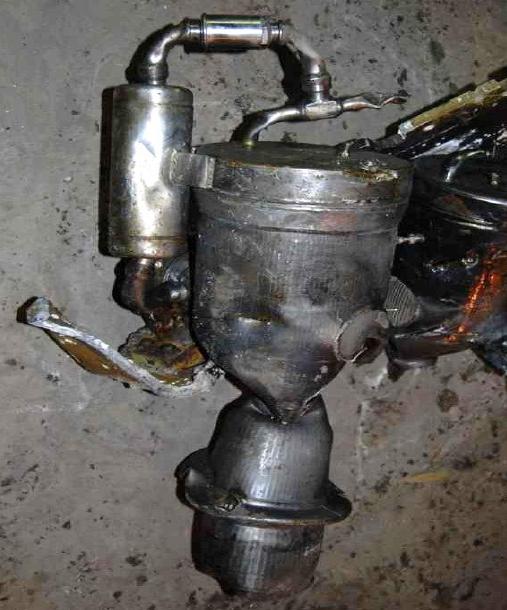North Korea’s launches of its Unha-3 rocket in April and December 2012, along with the recovery and analysis of debris from the December launch, have provided a lot of new information that was not previously available. That information has allowed me and others to reassess our earlier conclusions about Pyongyang’s rocket, and has led to some significant changes.
Some of the most detailed analysis based on this new information has been done by Markus Schiller and Robert Schmucker, two aerospace engineers working in Munich. They bring real-word, hands-on experience with rockets to this work. (For a report on North Korea’s missiles Markus published last year as a fellow at RAND, click here.)
Last week Markus gave a webinar and talked about his current understanding of the Unha-3. His webinar is available at the link below. Here is a summary of some of his main points:
(1) The first stage has now been shown, as expected, to use Scud fuel—kerosene and nitric acid. It uses a cluster of four Nodong engines, each with a thrust of about 27 tons. The body is made of a lightweight aluminum-magnesium alloy.
(2) The South Korean analysis of debris from the launcher showed that the first stage also included four small steering engines. South Korea’s assessment is that each of these four engines can deliver a thrust of 3 tons. While these look similar to the small engines of the Iranian satellite launcher’s upper stage, Markus notes that close examination shows they are entirely different in design and construction. While he does not have enough information about these engines to estimate their thrust, he believes the way they are connected to the fuel feed system could allow them to each deliver a thrust of 3 tons. (Note that this is a different conclusion than reported previously.) He also points out that steering engines have been used in missiles for more than 50 years so it’s not surprising that North Korea would have developed them for this launcher.
(3) Markus and Robert’s analysis of the second stage is the most interesting. Based on the amount of fuel, the burntime of the stage, and the launcher’s trajectory, they believe it also uses Scud technology, burning kerosene and nitric acid rather than more advanced propellants. More surprisingly, they find it is powered by a small engine—similar to a Scud engine—with a relatively low thrust of 13 to 14 tons, rather than a larger Nodong engine. This finding is particularly interesting for two reasons:
-Claims that the second stage of the Unha is based on the Soviet SSN-6 missile appear to be completely wrong. Ted Postol and I made this claim after the 2009 Unha-2 launch, based on the size of the stage and our computer modeling, which used information available at the time. Based on new information we no longer believe this stage was related to the SSN-6. This is an important change because it means that, despite speculation for many years about North Korea acquiring SSN-6 missiles or production equipment from the Soviet Union/Russia, North Korea has still not flight tested such a missile. While the Unha third stage and Iranian Safir second stage use small engines that appear similar to SSN-6 steering engines, there is no physical evidence that North Korea or Iran have acquired or can build the SSN-6 main engine.
-Markus points out that a low-thrust, long-burntime second stage is exactly what you would design for a satellite launcher, since you want a long boost phase to allow the satellite to reach high altitude before inserting the satellite into orbit. For a ballistic missile, on the other hand, such a design would cost you more than 1,000 km in range compared to using a Nodong engine in this stage. If you were designing a ballistic missile, you would therefore build it with a high-thrust, short-burntime second stage to maximize its range with a given payload.
(4) The third stage uses more advanced fuels—UDMH and NTO. While this stage looks similar to the upper stage on Iran’s Safir, there are differences in the details of the two stages, so they are not identical. The origin of the small engines in this stage is not known. While they may be components from a Soviet SSN-6 missile, these engines are simple enough that Markus thinks it is also possible that North Korea and/or Iran could have built and possibly designed them. So they may not be evidence of the transfer of SSN-6 missiles to Iran and North Korea. More information is needed to pin this down.
Markus and Robert are developing range-payload curves that should be available soon. Given the low thrust of the second stage, the ranges may be significantly shorter than some current estimates.
Based on their analysis Markus notes that in designing the Unha, North Korea made choices that are useful for a satellite launcher but decrease its ability as a ballistic missile. So while developing and testing the Unha gives North Korea experience with technology that can be used for a ballistic missile, reports that the launch was really a ballistic missile test parading as a satellite launch are not true.
Link to video: The recording of the Markus’ Feb. 14 webinar is 36 minutes long. We have posted it as a shockwave (.swf) file. The best way to view it is to open it in a web browser. Current versions of Google Chrome and Firefox seem to work, but I have had problems with IE. Note that for some reason the second slide does not appear, but the rest do. The file is about 5 Mb.

